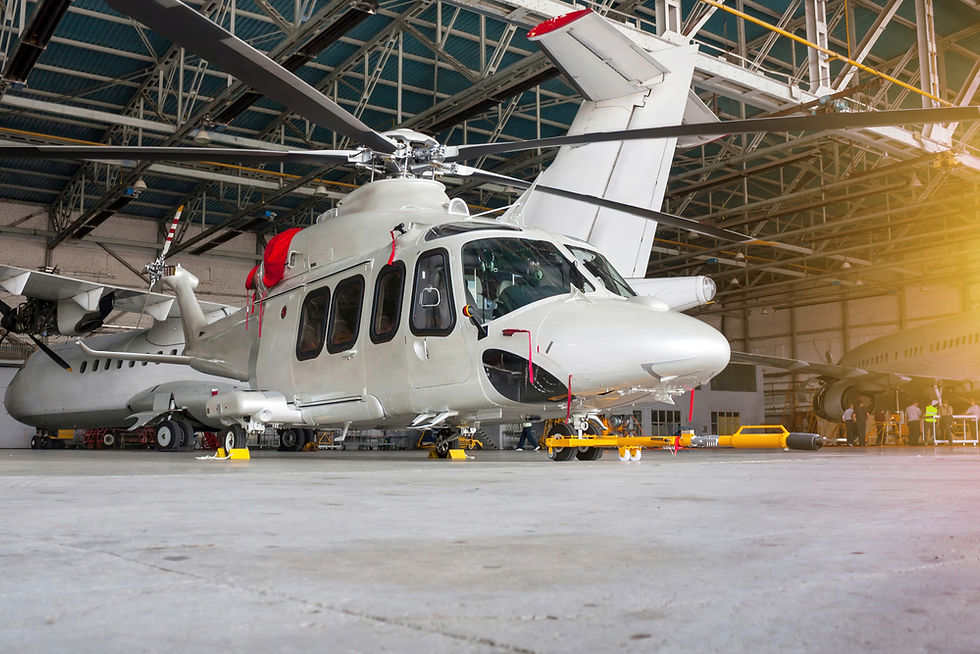Steps for Effective Aircraft Component Maintenance
- Naasco .
- Feb 4
- 4 min read
Updated: Feb 5

Maintaining aircraft components is essential for the safety, performance, and longevity of an aircraft. Proper aircraft component repair and overhaul ensures that every part of the aircraft, from the engines to the navigation systems, operates smoothly and efficiently. This not only ensures the safety of passengers and crew but also helps in reducing operational costs over time. Effective aircraft component maintenance involves regular inspections, timely repairs, and careful monitoring of each part to identify potential issues before they become serious problems.
In this guide, let’s explore key steps for maintaining aircraft components effectively,
1. Develop a Comprehensive Maintenance Plan:
A well-structured maintenance plan is the foundation of any successful maintenance program. It should include schedules for routine inspections, parts replacement, and repair protocols. This plan should be tailored to the specific needs of each aircraft model and should comply with both manufacturer guidelines and aviation safety regulations. Regularly reviewing and updating the maintenance plan ensures that it stays relevant and effective.
2. Conduct Regular Inspections
Inspections are one of the most critical aspects of aircraft component maintenance. Scheduled inspections help to detect early signs of wear and tear, preventing minor issues from escalating into major problems. Components such as engines, landing gear, fuel systems, and avionics should be checked regularly. Inspections must be thorough and cover all vital areas of the aircraft. Regular checks can significantly extend the lifespan of the components.

3. Ensure Proper Documentation
Documentation is key when it comes to aircraft maintenance. Every inspection, repair, and part replacement should be accurately recorded and filed. This allows for easy tracking of the maintenance history and provides essential data for future repairs or upgrades. Detailed records also help meet regulatory requirements and provide a clear overview of an aircraft’s maintenance journey.
4. Replace Worn-out Parts
Aircraft components have a lifespan and must be replaced when they show signs of wear. Regular checks should focus on identifying worn-out parts, such as tires, filters, and gaskets, which need to be replaced to maintain performance. Timely replacement of parts can prevent failures during flight and reduce the risk of costly repairs. Always use original parts or high-quality replacements that are compatible with the aircraft.
5. Perform Systematic Testing
Testing is another important step in ensuring that aircraft components are functioning correctly. After completing inspections and repairs, it’s essential to conduct operational tests. These tests should cover all critical systems, such as electrical, hydraulic, and flight control systems. Testing helps to ensure that everything works as expected and identifies any issues that may have been overlooked during the inspection.
6. Use Modern Technology and Tools
Advancements in technology have made it easier to monitor and maintain aircraft components. Using modern diagnostic tools and software can help detect issues that are not immediately visible. Technologies like computerized engine monitoring and predictive maintenance systems help identify potential problems before they cause failure. Aircraft operators and maintenance crews should invest in these technologies to improve the accuracy and efficiency of their maintenance programs.
7. Train and Certify Maintenance Personnel
Proper training and certification are crucial for the individuals responsible for aircraft maintenance. Aircraft maintenance professionals should have up-to-date knowledge of industry standards, safety protocols, and the latest technologies. Ensuring that all maintenance personnel are trained and certified ensures that they can perform their duties effectively and safely, which ultimately leads to higher-quality maintenance.
8. Maintain Component History
Every aircraft component should have a maintenance log that includes its service history. This log helps track any recurring issues and provides insight into which components may require more frequent attention. It also helps assess the overall health of the aircraft and identify patterns that might suggest problems with specific parts. Keeping a detailed history of each component is essential for long-term maintenance planning and cost estimation.
9. Ensure Safety and Compliance
Safety should always be the top priority in aircraft maintenance. Every maintenance procedure must be conducted following strict safety guidelines. Adhering to aviation regulations and safety standards is not only required but also helps maintain the integrity of the aircraft and its components. Ensuring compliance with both local and international standards prevents accidents and promotes the aircraft’s overall reliability.
10. Monitor Aircraft Performance
After performing maintenance tasks, monitoring the aircraft’s performance is crucial. By closely observing how the aircraft functions after maintenance, you can spot any irregularities early on. Performance metrics like fuel efficiency, engine response, and handling should be closely monitored. Regular performance evaluations can help maintain the aircraft’s operational efficiency and ensure its components are working optimally.
11. Adopt Preventative Maintenance
Preventative maintenance is a proactive approach that focuses on preventing issues before they occur. This can include regular inspections, cleaning, lubricating parts, and addressing minor issues before they turn into bigger problems. Preventative maintenance extends the life of aircraft components, reduces the likelihood of unplanned repairs, and ensures that all parts remain in optimal condition for longer.
12. Invest in Quality Parts and Services
Using quality parts and services is essential for maintaining the integrity of aircraft components. Always opt for genuine parts and services that meet or exceed industry standards. While cheaper alternatives may seem attractive, they can lead to more frequent breakdowns and costly repairs. Investing in quality ensures that the aircraft operates efficiently and remains in service longer, minimizing downtime and operational costs.

Conclusion
Effective aircraft Maintenance Repair and Overhaul Aviation is a continuous process that requires careful planning, attention to detail, and adherence to safety regulations. By following these steps, aviation professionals can ensure that their aircraft remains in excellent condition, providing safe and reliable service to passengers. At Naasco, they understand the importance of high-quality maintenance services. The team is dedicated to delivering the best solutions for your aircraft, ensuring it stays in optimal condition for years to come. Visit the website and get more information!



Comments